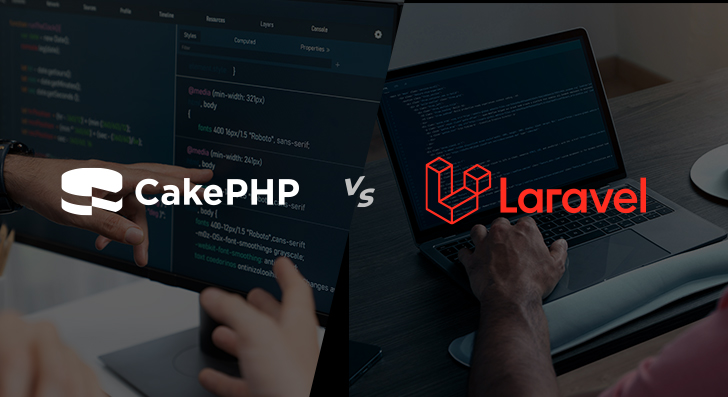PHP has come a long way since its introduction in 1995. Today, this general-purpose scripting language is used by 76.4% of all websites with a known server-side programming language. In other words, PHP powers nearly 3/4th of websites using PHP in some way or another. From this, PHP remains a strong contender, despite the emergence of disruptive technologies, such as Blockchain, Artificial Intelligence, Machine Learning, the Internet of Things (IoT), Augmented Reality, Virtual Reality, and more. The reason behind the dominance of PHP in the realm of web development is that it comes with a plethora of frameworks that allow developers to add custom features and functionalities to websites or web applications without requiring any third-party tools or plugins. Among all PHP frameworks out there, CakePHP and Laravel frameworks are immensely popular among web developers.

At first glance, both CakePHP and Laravel may look similar on the surface, since both the frameworks are written in PHP, free and open-source in nature, follow the model–view–controller (MVC) architectural pattern, and are backed by a large and active community. However, the real difference between both frameworks can be unveiled by dissecting their benefits, features, development costs, and more. Let’s dive deep into this detailed and informative piece.
Table of Contents
- CakePHP – A Quick Rundown
- Laravel – A Quick Rundown
- CakePHP vs Laravel: Pros and Cons
- Popular Web Solutions Engineered with CakePHP
- Popular Web Solutions Engineered with Laravel
- CakePHP vs Laravel: A Side-by-side Comparison
- CakePHP vs Laravel: A Detailed Comparison
- When to Choose CakePHP for a Web Development Project
- When to Choose Laravel for a Web Development Project
- CakePHP vs Laravel: Development Costs
- Summing Up
CakePHP – A Quick Rundown
CakePHP is a free and open-source PHP framework developed on an HMVC (hierarchical model view controller) architecture. It is widely used for developing and maintaining web applications. Developers can leverage the environment flexibility of CakePHP to create microservices web applications that load rapidly. Furthermore, it has built-in support for safe request handling, business logic, validation, unit testing, and other similar capabilities. CakePHP also provides robust support for databases like SQL Lite, MYSQL, PostgreSQL, and more. Since the framework operates on a document-oriented database model, it facilitates data storage in JSON format instead of rows and columns. To date, there are over 40k live websites using CakePHP, making it a popular PHP framework.
Laravel – A Quick Rundown
Released back in 2011, Laravel is another popular open-source PHP framework that is widely used for creating dynamic and fully functional web applications. It comes with an expressive command-line interface (CLI), which eliminates the need for repetitive, tedious, and manual coding tasks. Furthermore, it supports concurrent unit testing, empowering developers to not only test multiple units at once but also prevent potential errors that arise due to unexpected changes. Today, Laravel is recognized as one of the most popular PHP frameworks owing to its Object Relational Mapping (ORM) features.
CakePHP vs Laravel: Pros and Cons
Pros of using CakePHP
- Easily Readable
Cake PHP facilitates the creation of reusable code components that can be reused across several web development projects. Instead of adding new libraries, the functionality can be transferred to components, plugins, helpers, and behavior. - No Pre-Configuration Required
Another key advantage of using CakePHP is that it saves developers time by automatically performing the configuration settings that need to be made. This simply means that developers need not invest time in configuring Linux Apache MySQL PHP setup. - Object-Relational Mapping
CakePHP comes with a built-in ORM (Object-Relational Mapping) that not only simplifies database interaction but also enhances code readability by allowing web developers to work with databases using an object-oriented syntax. - Built-In Libraries
With the built-in modules and libraries, CakePHP allows developers to quickly build robust and adaptable websites and web applications. - Active Community
CakePHP is backed by an active community of developers that is committed to providing end-to-end support and enhancing the capabilities of this open-source PHP framework. - MVC Architecture
CakePHP follows the MVC (Model-View-Controller) architecture pattern, providing developers with an organized and structured approach for organizing code and separating concerns to promote modularity, code reusability, and maintainability. - Database Support
CakePHP offers multiple database support including MySQL, SQLite, PearDB, SQL Server, PostgreSQL, and Oracle, providing developers flexibility in database selection based on project requirements. - Rich Documentation
CakePHP comes with exhaustive and well-maintained documentation, including tutorials and guides and API documentation that allows developers to walk through common workflows and tasks such as handling form submissions, implementing authentication and authorization, and more. - Built-In Features
CakePHP comes with a host of built-in features such as data validation, scaffolding, ORM (Object-Relational Mapping), authentication, and caching, which eliminates the need for third-party tools and simplifies web development.
Cons of Using CakePHP
- Steep Learning Curve
There is a steep learning curve for developers not familiar with MVC (Model-View-Controller) architecture. - Community Size
Compared to other PHP frameworks like Laravel, the community size of CakePHP is relatively small. A smaller community means fewer community-driven resources, plugins, and packages. - Ecosystem Maturity
While CakePHP has been around for nearly two decades, the ecosystem of this open-source PHP framework might not be as mature as other frameworks.
Mastering the Web Development Landscape with PHP
Pros of Using Laravel
- Blade Templating Engine
Laravel comes with a robust and intuitive tool that provides developers with a clean and concise syntax for writing templates. It also supports features like template inheritance, loops, conditionals, and partials, enhancing developer productivity, encouraging code reusability and maintainability, and contributing to the readability of Laravel applications. - Artisan Command Line Interface (CLI)
Laravel’s Artisan Command-Line Interface (CLI) is a powerful tool that provides several helpful commands to streamline the development workflow, automate repetitive tasks, generate boilerplate code, seed databases, run migrations, clear caches, and manage various aspects of a Laravel application, resulting in enhanced developer productivity. In other words, Artisan CLI empowers web developers to build high-quality applications faster and more effectively. - MVC Architecture
Like CakePHP, Laravel follows the Model-View-Controller (MVC) architectural pattern, which promotes the separation of concerns into distinct components and improves code organization, maintainability, and scalability, making it easier to manage complex applications. Furthermore, the MVC architecture fosters smooth collaboration among development teams by providing a clear and consistent structure for code organization and communication.
Cons of Using Laravel
- High Development Cost
Though Laravel is free and open source in nature, hiring Laravel developers for web development is a costly affair as compared to other frameworks. - Limited Support
Unlike other open-source frameworks, support for Laravel is not readily available and this might increase the risk of system downtime. - No Built-In support function
Unlike Ruby on Rails and Django, Laravel has limited built-in support.
Popular Web Solutions Engineered with CakePHP
CakePHP powers some of the popular names including BMW, Edureka, Hyundai, SeatGeek, Form Assembly, and more. Given the list featuring popular brands using CakePHP, you might wish to leverage the potential of this open-source PHP framework. If you do, you may hire top CakePHP developers from a reliable web development company.
Popular Web Solutions Engineered with Laravel
Websites like Alison, October, Invoice Ninja, Barchart, MyRank, AsgardCMS, World Walking, Neighbourhood Lender, and more are built using the Laravel framework. If you also wish to craft a popular web solution using this framework, you may hire top Laravel developers from a professional PHP development company.
CakePHP vs Laravel: A Side-by-Side Comparison
| Category | CakePHP | Laravel |
|---|---|---|
| Speed | Faster than Laravel | Not the fastest |
| Routing | Easy to implement | Difficult to implement |
| Data Backup | The data backup option is limited | Better data backup options |
| Templating Engine | Doesn’t provide a flexible templating engine | Flexible template engine |
| Data Handling | Not as efficient as Laravel | Highly efficient |
| Security | More secure than Laravel | Good security |
CakePHP vs Laravel: A Detailed Comparison
This detailed comparison between CakePHP and Laravel will help you understand the key differences between both frameworks. Let’s have a look.
CakePHP vs Laravel: Plugins
CakePHP
CakePHP offers a host of plugins that not only keep the code clean, organized, and efficient but also make the application readable and compact. Furthermore, the plugins support critical functions like security, authentication, migration, debugging, and asset management.
Laravel
Unlike CakePHP, Laravel does not provide a wide assortment of plugins, which in turn, leads to poor reusability within the code.
Winner – CakePHP
CakePHP vs Laravel: Performance
CakePHP
CakePHP has undergone performance improvements in the past few years. It utilizes caching mechanisms and an ORM (Object-Relational Mapping) system to improve application speed. In certain scenarios, CakePHP may deliver slightly faster performance owing to its simpler architecture.
Laravel
Laravel, on the other hand, excels in performance due to its optimized database query builder and efficient routing system. Being a more recent framework, Laravel benefits from better template engines, modern optimization techniques, and a rich ecosystem of tools and packages that contribute performance enhancements and optimizations.
Winner – It’s a Tie
CakePHP vs Laravel: Scalability
CakePHP
Built on the MVC architecture, CakePHP is best suited for small-scale web development projects that require less complexity. Though large-scale applications can be developed in CakePHP, however, it is a piece of cake in Laravel.
Laravel
Laravel is considered ideal for complex, large-scale web development projects. Using this framework, developers can build fully functional eCommerce stores and enterprise-level web applications with ease.
Winner – Laravel
The Ultimate Guide to Hiring PHP Developers Right the First Time
When to Choose CakePHP for a Web Development Project
Choose this open-source PHP framework when planning to develop web solutions with limited functionalities.
When to Choose Laravel for a Web Development Project
It’s considered wise to choose this framework for building web solutions that demand faster time-to-market.
CakePHP vs Laravel: Development Costs
Region Wise Average Hourly Rate in USD
| Region | CakePHP | Laravel |
|---|---|---|
| North America | $38 – $65 | $60 – $120 |
| Australia | $38 – $58 | $40 – $100 |
| Western Europe | $35 – $55 | $50 – $110 |
| South America | $22 – $38 | $25 – $70 |
| Eastern Europe | $18 – $32 | $30 – $80 |
| Asia | $15 – $25 | $20 – $60 |
Source: clouddevs.com
Summing Up
After comparing CakePHP and Laravel, it can be concluded that both frameworks are immensely popular and have their own pros and cons. The decision to choose any one of them depends on the project requirements, developer familiarity, and business objectives. For instance, if you are planning to build a simple small-scale web application with no plans of scaling further, you may consider CakePHP. On the other hand, if you are planning to build a complex, large-scale web application, such as an eCommerce store, you may consider Laravel.





